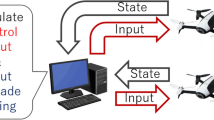Abstract
The paper presented in this article deals with the issue of distributed cooperative formation of multi-agent systems (MASs). It proposes the use of appropriate neural network control methods to address formation requirements. The paper considers distributed cooperative formation control using a leader-follower approach. The paper also employs neural networks to overcome control challenges while dealing with complex systems or complex conditions. The neural network model was designed and the leader-follower formation control protocol was proposed. The sufficient conditions for the system stability were derived using Lyapunov stability theory, graph theory, and state space methods. By simulating the results of this study, the main data of the formation process can be observed to analyze and verify whether the system meets the requirements. Finally, by using an example of 16 agents to generate a hexagonal formation, it is verified that the system achieves consistency, stability, reliability, and accuracy in the cooperative formation.
Access this chapter
Tax calculation will be finalised at checkout
Purchases are for personal use only
Similar content being viewed by others
References
Wang, W., Huang, J.S., Wen, C.Y., Fan, H.J.: Distributed adaptive control for consensus tracking with application to formation control of nonholonomic mobile robots. Automatica 50(4), 1254–1263 (2014)
Zhang, J., Liu, W., Li, Y.: Optimal formation control for second-order multi-agent systems with obstacle avoidance. IEEE/CAA J. Autom. Sinica 10(2), 563–565 (2023)
Zhi, H., Chen, L., Li, C., et al.: Leader–follower affine formation control of second-order nonlinear uncertain multi-agent systems. IEEE Trans. Circuits Syst. II Express Briefs 68(12), 3547–3551 (2021)
Jia, Z., Wang, L., Yu, J., et al.: Distributed adaptive neural networks leader-following formation control for quadrotors with directed switching topologies. ISA Trans. 93, 93–107 (2019)
Dong, X.W., Yu, B.C., Shi, Z.Y., Zhong, Y.S.: Time-varying formation control for unmanned aerial vehicles: Theories and applications. IEEE Trans. Control Syst. Technol. 23(1), 340–348 (2015)
Shen, Q., Shi, P.: Output consensus control of multiagent systems with unknown nonlinear dead zone. IEEE Trans. Syst. Man Cybern. Syst. 46(10), 1329–1337 (2015)
**e, Y., Han, L., Wang, R., et al.: Group formation control for nonlinear second-order multi-agent systems using neural networks. In: Proceedings of the 2019 Chinese Automation Congress (CAC), pp. 1132–1137, IEEE (2019)
He, S., Wang, M., Dai, S., Luo, F.: Leader–follower formation control of USVs with prescribed performance and collision avoidance. IEEE Trans. Industr. Inf. 15(1), 572–581 (2019)
Gou, X., **, W.: Multi-agent system for multimedia communications traversing NAT/firewall in next-generation networks. In: Proceedings of the Conference on Communication Networks and Services Research, pp.99–104, IEEE (2004)
Peng, Z., Wen, G., Rahmani, A., Yu, Y.: Distributed consensus-based formation control for multiple nonholonomic mobile robots with a specified reference trajectory. Int. J. Syst. Sci. 46(8), 1447–1457 (2015)
Peng, Z., Wen, G., Yang, S., Rahmani, A.: Distributed consensus-based formation control for nonholonomic wheeled mobile robots using adaptive neural network. Nonlinear Dyn. 86(1), 605–622 (2016)
Kuriki, Y., Namerikawa, T.: Consensus-based cooperative formation control with collision avoidance for a multi-UAV system. In: Proceedings of the 2014 American Control Conference, pp. 2077–2082. IEEE (2014)
Mu, C., Han, L., Wen, Y., et al.: Formation control for second-order discrete-time multi-agent systems with nonlinear dynamics using neural networks. In: Proceedings of the 2020 Chinese Automation Congress (CAC), pp. 5096–5096. IEEE (2020)
Fei, Y., Shi, P., Lim, C.C.: Neural network adaptive dynamic sliding mode formation control of multi-agent systems. Int. J. Syst. Sci. 51(11), 2025–2040 (2020)
Wen, G., Zhang, C., Hu, P., et al.: Adaptive neural network leader-follower formation control for a class of second-order nonlinear multi-agent systems with unknown dynamics. IEEE Access 8, 148149–148156 (2020)
Dong, X., Hu, G.: Time-varying output formation for linear multiagent systems via dynamic output feedback control. IEEE Trans. Control Netw. Syst. 4(2), 236–245 (2017)
Zou, A.M., Kumar, K.D.: Neural network-based adaptive output feedback formation control for multi-agent systems. Nonlinear Dyn. 70, 1283–1296 (2012)
Yuan, C., He, H., Wang, C.: Cooperative deterministic learning-based formation control for a group of nonlinear uncertain mechanical systems. IEEE Trans. Industr. Inf. 15(1), 319–333 (2019)
Mei, F., Wang, H., Yao, Y., et al.: Robust second-order finite-time formation control of heterogeneous multi-agent systems on directed communication graphs. IET Control Theory Appl. 14(6), 816–823 (2020)
Liu, X., **e, Y., Li, F., et al.: Time-varying formation control of singular multi-agent systems with multiple leaders. In: Proceedings of the 16th International Conference on Control and Automation, pp.193–198. IEEE (2020)
Author information
Authors and Affiliations
Corresponding authors
Editor information
Editors and Affiliations
Rights and permissions
Copyright information
© 2024 The Author(s), under exclusive license to Springer Nature Singapore Pte Ltd.
About this paper
Cite this paper
Moeurn, S.K., **n, B. (2024). Neural Network Control of Distributed Cooperative Formation of Multi-agent System. In: **n, B., Kubota, N., Chen, K., Dong, F. (eds) Advanced Computational Intelligence and Intelligent Informatics. IWACIII 2023. Communications in Computer and Information Science, vol 1932. Springer, Singapore. https://doi.org/10.1007/978-981-99-7593-8_24
Download citation
DOI: https://doi.org/10.1007/978-981-99-7593-8_24
Published:
Publisher Name: Springer, Singapore
Print ISBN: 978-981-99-7592-1
Online ISBN: 978-981-99-7593-8
eBook Packages: Computer ScienceComputer Science (R0)



